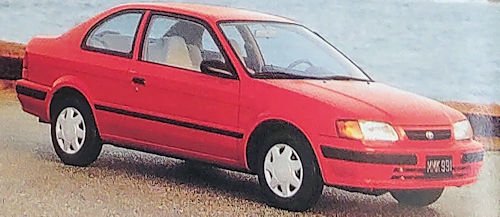Toyota Tercel 5th Generation (L50)
 |
|
|
Production |
1994 to 2000 |
|
Assembly |
Japan: Taiwan: Thailand: Indonesia |
|
Body style |
|
|
Layout |
Transverse front-engine, front-wheel-drive |
|
Engines |
|
|
Transmission |
|
|
Wheelbase |
2,380 mm (93.7 in) |
|
Length |
|
|
Width |
|
|
Height |
|
In September 1994, the Tercel L50 was launched worldwide. The chassis was similar to that of its predecessor, but the bodies were redesigned and more torsion rigid. In Japan, the sedan was again Toyota Corolla II and the hatchback now only Toyota Corsa. The dashboard was also installed in the Toyota Starlet and Toyota Paseo. Again, exclusively in North America there was a coupe version, while the hatchback was not available there. There, the Tercel was also one of the few cars that had an OBD-II connector for fault selection. On the home market, the base model was now, ranked above Avenue and VX and there was also optional four-wheel drive available. Beside ABS and driver airbag also a passenger airbag counted everywhere to the standard equipment, only in Canada was available in the base model only as an option. As a further improved safety equipment now three-point seat belts were installed. For Central and South America, the Tercel was now in Zhongli (Taiwan)still with the 1.3-liter carburettor engine 2E-FE with 58 kW (79 hp) installed, in the other markets the same strong 4E-FE with gasoline injection. Only in Japan was the 1453 cc 1N-T turbodiesel with 49 kW (67 hp) again available, while the 1.5-liter gasoline engine 5E-FE was a revised version of its predecessor and now with 69 kW (94 hp) had 13% more torque and 15% less fuel. In some markets and in the home market, he was also available with 70 kW (95 hp). As before, the 1.3-liter engines were not available in North America and only with 4-speed manual or 3-speed automatic transmissions and 1.5-liter engines with 5-speed manual or 4-speed -Automatic.
- In Chile, the 5th generation was introduced in September 1995 with a 70 kW (95 hp) version of the 1.5-liter gasoline engine 5E-FE and voted Car of the Year in Chile. Until the end of production, he was the second bestselling car there.
- A facelift took place in December 1997 with ventilation rotary controls, revised seat covers and door panels, automatic instead of manual air conditioning and improved ignition systems for all gasoline engines.
Externally, the front was redesigned with new headlights, new grille and front bumper. In addition, there were now clear light indicators front and rear. Also, the rear received new taillights and bumpers. As a result, the series was now longer and wider.
- In mid-1998, the Tercel models were replaced in the US by the Toyota Echo.
- End of 1998 sparked in Japan there Toyota place called Echo the Tercel sedan Corolla II from.
- In 1999, the sale of the Tercel inclined rear Toyota Corsa was discontinued in Japan, which had already received since late 1998 with the Toyota Vitz a successor model. Until 2000, the Tercel was still offered in Canada, Puerto Rico and other countries. After the production in Japan was discontinued in 1999, the models came last from Taiwan, where production ran until the beginning of 2000.
Everywhere the Toyota Echo and / or Toyota Vitz was the successor model
As Soluna, the Tercel L50 sedan was marketed with a different front in Asia outside of Japan. It was built in Thailand and Indonesia. The drive here was the 1.5-liter 5A-FE gasoline engine used. Especially as a taxi the Soluna was widely used in these two countries. In 2002, the Soluna was replaced by the Toyota Vois.
Technical
-
Dimensions (3-door hatchback)
Length: 161.8 in.
Width: 64.8 in.
Wheelbase: 93.7 in.
Weight: 1950 lbs.
Powertrain (front-drive)
Engine:
1 .5L carbureted 4 (82 hp)
Transmissions:
4-speed manual
5-speed manual
Option: 3-speed automatic
Fuel Economy
1.5L & 4-speed man.: 7.01-1100 km
1.5L & 5-speed man.:7.8L/100km
1.5L & 3-speed auto.:8.3L/100 kmToyota 2E engine Technical details and specifications (1985-1999)
No. of cylinders 4/OHC
Capacity 1295 cc
Firing order 1-3-4-2
Compression ratio 9,5:1
Suitable for unleaded petrol Yes
Minimum octane rating 91 RON
Fuel system Make Aisan Type 21100-11150
Ignition coil Make Denso Type 90919
Distributor Make Denso No. 11030
Fuel system pressure 0,2-0,3 bar
Compression pressure 10-13 bar
Oil pressure 2,5-5,0 bar @ 3000 rpm
Radiator cap pressure 0,75-1,05 bar
Thermostat opens 80-84 °C
Starter motor Make Denso Type 1,0 kW
Maximum cranking amps 122-149 A
Alternator/Regulator Make Nippon Denso Type 45A
Regulated voltage 13,5-15,1V
Service
-
Toyota 2E engine Maintenance and Service Guide (1985-1999)
Distributor Contact breaker gap 0,45mm
Distributor Dwell angle 46-58° (51-64%)
Spark plugs Original equipment NGK Type BPR6EY-11
Spark plugs Electrode gap 1,1 mm
Spark plugs Tighten 18 Nm
Spark plugs Make Bosch Type WR8DCX
Spark plugs Make Champion Type RN9YCC4
Valve clearance -INLET 0,20mm check hot
Valve clearance -EXHAUST 0,20mm check hot
Drive belt tension - alternator 5-6mm
Engine oil grade - normal or moderate climate 10W/30 SAE or 10W/40 SAE
Engine oil grade - cold climate 5W/30 SAE
Engine oil grade - hot climate 20W/40 SAE
Engine oil change with filter 3,2 litres
Sump drain bolt tighten 25 Nm
Cooling system 4,6 litres
Cylinder head Tightening torques (Renew bolts No)
Stage 1 Tighten 29 Nm
Stage 2 Tighten 49 Nm
Stage 3 Tighten 90°Gearbox
5-speed manual gearbox: C150, C152 (turbo model)
Automatic transmission: A132
Manual gearbox oil grade 75W-90W SAE
Manual gearbox oil 2,4 litres
Automatic transmission fluid Type Dexron II
Automatic transmission fluid 2,2 litres
Differential front/Auto 1,4 (AT) litres
Differential oil grade - rear Dexron II© Motor car History
